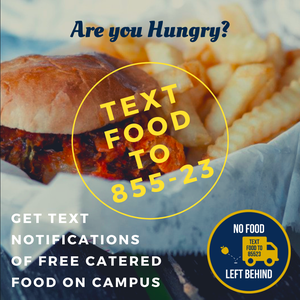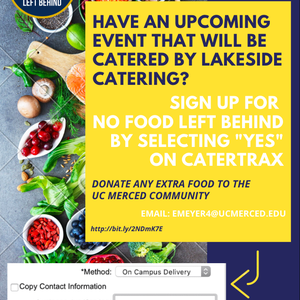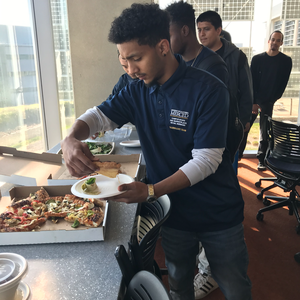No Food Left Behind: A free text service to reduce food insecurity and food waste
University of California, Merced
Project Overview
No Food Left Behind is a free text messaging service that connects students, staff and faculty at the University of California, Merced to events that might have food leftover. People are encouraged to bring Tupperware to these events to collect any remaining food which simultaneously reduces food waste and food insecurity.
Background
Events are notoriously wasteful. Event planners tend to over order to prevent running out. Often times, this over ordering in combination with people not showing up for events amongst other reasons leads to perfectly good food being wasted. The University of California, Merced hosts many events for the UC community and the public and the UC also has a Triple Zero Commitment with the aim of reducing food waste. As such, No Food Left Behind was launched to reduce event food waste while feeding our food insecure population. No Food Left Behind is a free text messaging service that connects the UC Merced community to events that might have food left over.
Event planners register their events as No Food Left Behind Events on CaterTrax when they order food. Then an invoice is sent to the program coordinator. A text message is then created and sent out to the UC community generally 24 hours before the event. This text includes information about where the event is, what time it is and what kind of food may be available. The UC community then are allowed to gather leftovers in a 15 minute window after the event concludes.
Goals
The goals are to save food and fight food insecurity. Specifically, we aimed to reduce food waste by 1000 pounds by the end of the Spring semester. We sought to enroll 1,250 on the text service by the end of the Spring semester.
Implementation
July 2019- Program planning began by conducting meetings with stakeholders (Office of Sustainability, Dining Services. Environmental Health and Safety) to discuss the logistics and to set up CaterTrax for event registration. The Students First Center had a text service already so a meeting occurred and a collaboration was put in place to utilize their text service with a special short code for No Food Left Behind. Social media accounts were set up. Data collection processes were put in place. August 2019- Marketing, promotion and outreach began. The program launched with the start of the fall semester. Event planners began registering events and participants began enrolling for texts. September 2019- A Student Success Intern was hired to help with marketing and data collection. September 2019- A contest was conducted to have students design and pick the logo. The winning student worked with the University’s communication team to maintain branding and the logo was finalized. October 2019- Additional collaborations were sought to further reduce event food waste. The initial program only worked with Dining Services so only events catered by Lakeside Catering were able to participate. However, event planners have the option of ordering from external vendors. In October. it was announced that the UC would be centralizing food ordering from external vendors on a platform called America to Go. Therefore, a collaboration was sought and established with America to Go to allow event planners to mark their events as No Food Left Behind Events on this platform as well. January 2020- Program coordinators were notified that clubs and organizations wanted to get involved as they were wasting food at events as well. A collaboration began with the Office of Student Involvement so that clubs and organizations could register their events as No Food Left Behind Events on CatLife, the platform they use to register any event off or on campus. March 2020- No Food Left Behind had to be placed on hold due to COVID-19. At this point, the program was on track to surpass the program goals. More than 850 pounds of food had been saved and 1,184 people were signed up to get texts. April 2020- The Student Success Intern virtually presented her work on the program. April 2020- No Food Left Behind was awarded a $5,000 grant from the University’s Office of Equity, Diversity and Inclusion.
Timeline
July 2019- Program planning and stakeholder engagement began. August 2019- The program officially launched. September 2019- A Student Success Intern was hired. September 2019- A logo contest was conducted. October 2019- March 2020- Additional collaborations were set up and the program and processes were refined. March 2020- No Food Left Behind was placed on hold due to COVID-19. April 2020- The Student Success Intern presented at a Virtual Symposium. April 2020- A $5,000 grant was awarded.
Financing
$2000 was been spent on the text messaging service. The Student First Center sponsored the costs for the text service from August 2019-December 2019. A rate of $800 per month was negotiated with them. Texts were sent out for only half of the month of March therefore only $2000 was spent.
There were plans to use funding from a grant for marketing materials, but these funds were not used due to pausing the program.
Results
1,184 people signed up for texts. There were more than 125 No Food Left Behind Events. More than 850 pounds of food was saved. However, this number likely should be much higher. Due to short staffing, staff or student staff could not attend all events for data collection. Only about 50% of the events were attended, thus data was collected for only 50% of the events.
Lessons Learned
It is very important to conduct stakeholder mapping and invite all to the table at the start of program planning. The program likely would not have been as successful without this component. It is important to get feedback and have the flexibility to pivot. For example, sometimes texts were sent out 24 hours before the event and sometimes texts were sent out the morning of the event. After gathering feedback that said 24 hours was preferred, the approach was tailored and all texts were sent the day before. Communication and marketing should be planned rigorously. Occasionally, event planners would mark their event as a No Food Left Behind Event without really knowing what it is. Then people would go to the event to collect food and event planners would be confused as to why they were there. More marketing and communication could help with that.




